Why and why not Dobsonians?
Absolute best bang for your buck
Simple and easy to use
Sturdy and stable
Not for long exposure astrophotography
Fairly bulky and heavy
Produces diffraction spikes
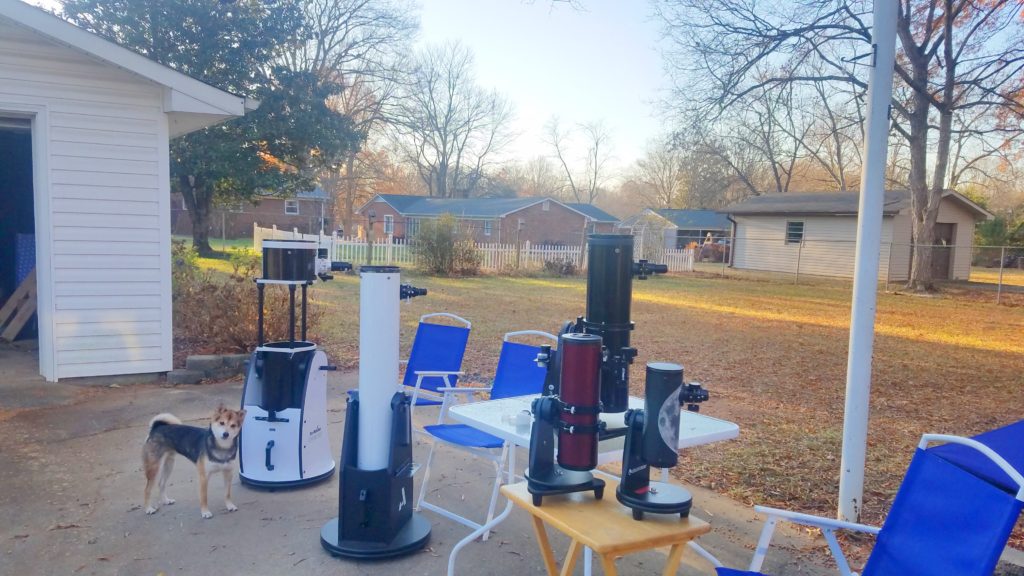
The Best Tabletop Dobsonian Telescopes
Best Overall:
9/10
Nearly flawless
Runner-up:
SkyWatcher Heritage 130P/AWB OneSky 130
8/10
Very good, but not that great
Budget Pick:
8/10
Very good, but not that great
Cheap “toy”:
FirstScope/Funscope or Zhumell Z100/Orion Skyscanner
6/10
Recommended with reservations
“Giant” tabletops:
SkyWatcher Heritage 150P and Orion StarBlast 6
8/10
Very good, but not that great
Odd one out:
Orion SkyQuest XT4.5
8/10
Very good, but not that great
Best 6″ Dobsonian Telescopes
Best Overall:
10/10
Metaphysical Perfection
Runner-up:
9/10
Nearly flawless
Best 8″ Dobsonian Telescopes
Best Overall:
The GSO Deluxe Dobs (Apertura AD8 or Zhumell Z8)
10/10
Metaphysical Perfection
Compact:
9/10
Nearly flawless
Best 10″ Dobsonian Telescopes
Best Overall:
The GSO-Deluxe Dobs (Apertura AD10 or Zhumell Z10)
10/10
Metaphysical Perfection
Compact:
9/10
Nearly flawless
Best 12″ Dobsonian Telescopes
Best Overall:
The GSO-Deluxe Dobs (Apertura AD12 or Zhumell Z12)
10/10
Metaphysical Perfection
Compact:
9/10
Nearly flawless
What’s a Dobsonian and how does it work?
A Dobsonian reflector is a Newtonian reflector mounted on a simple, strong, and easy-to-use mount that moves up, down, and left and right. It’s the simplest way to aim above the horizon, as it eliminates the need to mess with an equatorial mount’s complicated and expensive hardware.
A Newtonian telescope has a paraboloidal mirror at the back, a flat diagonal at the front, and an eyepiece at the front of the side. To look through a Dobsonian, you usually set the telescope on the ground, aim the telescope, and sit in a chair next to the eyepiece.
A Dobsonian is made up of two parts (in fact, these parts usually ship in separate boxes); the Optical Tube Assembly (OTA) and the Rockerbox. The OTA is the reflector telescope itself, and the rocker box is the mount. A rockerbox has to be able to smoothly move left and right, up and down, and smoothly enough that you can push it in a diagonal motion without it sticking. Traditionally, this is done with large Teflon bearings, but some commercial telescope manufacturers have come up with different solutions.
Dobsonians combine easily manufactured large-aperture reflector optical tubes with dirt-cheap but very functional mounts, making them the absolute best bang for your buck of any telescope design. They were originally introduced by sidewalk astronomer John Dobson as a cheap and affordable way to build a large telescope to show the universe to people. They took off so much that it is now cheaper to buy a completed Dobsonian than to make one yourself until you reach about 12 inches or so in aperture.
Because part of the beauty of the Dobsonian is its simplicity and ability to be pushed around manually, I will not be touching on the computerized Dobsonians available. Computerization in the imported Dobsonians is never really at the same level of quality as the computerization in dedicated astrophotography mounts–though they are, to be fair, quite a bit cheaper–and in large part, they take out the fun of observing, the thrill of the hunt. Books like “Turn Left At Orion”, star maps, and practice will get you pushing your telescope wherever you want.
Dobsonian’s Advantages and Disadvantages
Advantages:
- Absolute best bang for your buck. There’s no cheaper way to get a functional large-aperture telescope on a sturdy mount. For example: compare the price of an 8” Dobsonian to an 8” SCT, or if you really want a shock, try finding a price on an 8” Refractor.
- Simple and easy to use. No counterweights, clutches, slow-motion-knobs, locks and switches and dials, no hand controllers–just a big tube that you shove where you want it to go.
- Sturdy and stable. Many beginner telescopes are on wobbly, undersized tripods and mounts. Dobsonians and Tabletop Dobs can be almost rock-steady, reducing wobble and vibrations.
- Finding objects by star-hopping with a manual telescope mount will help you learn the night sky by doing. And then there’s the thrill of the hunt.
- A subtle difference: SCTs and Maksutovs tend to have larger obstructions than Newtonian reflectors, which slightly reduces contrast and resolution.
Disadvantages:
- Dobsonians can’t track the sky for long exposure astrophotography. Lunar and Planetary photography is possible but limited, but photography of Deep-Sky-Objects is difficult and not really doable.
- Some visual Newtonians, including many Dobsonians won’t even reach focus with a DSLR attached, unless a Barlow magnifier lens is added to the light path to shunt the focus point further out.
- Solid-Tube Dobsonians are fairly bulky, heavy things. Telescopes of similar aperture tend to weigh as much or more, but SCTs and Maksutovs are more compact and can sometimes be stored more compactly, especially when travelling.
- Most Newtonian reflectors have four spider vanes which hold up the secondary mirror, producing diffraction spikes. Some people like them, but others find them distracting. SCTs, Maks, and Refractors don’t have spikes.
- The central obstruction of Newtonians slightly reduces their contrast and resolution compared to a refractor of the same size. (However, the cost of a good refractor is immense compared to a Dobsonian of the same size.)
How to Decide on the Aperture Size?
As a reminder, when we discuss telescopes, the important number is the aperture, or in this case, the diameter of the primary mirror.
The commercial Dobsonians we will be examining in this article have between 6 and 12 inches of aperture (except for the smaller tabletop dobsonians, which we will discuss briefly as well). They all have very good optics—none of them is really better than another within their size class. The small, skinny ones tend to be better than the larger, stouter ones in terms of the optical figure of the glass, but the large ones are capable of outperforming the resolution of the small ones by simple aperture alone.
There are two reasons why we want the biggest aperture we can get:
- The bigger the front opening, the more light the telescope gathers, and the brighter the images will be. Fainter objects become more visible, brighter objects become more spectacular.
- Due to the wave nature of light, all else being equal, the telescope with the largest aperture has the highest resolution, so you can reach higher magnifications.
That is, a larger aperture telescope typically shows images that are simply much more spectacular than what you can see at the same magnification with smaller telescopes.
There are also a few reasons, to be fair, why you might not want the biggest aperture dob:
- Very large telescopes are also typically very heavy, bulky things that may be too difficult to reliably take outside, are harder to transport, and take up somewhat more space. Very large telescopes cost much more due to material and labor costs.
- The heavier Dobsonian telescopes are mechanically stiffer and harder to aim and track with. They get a little top-heavy and tend to require aftermarket counterweights on the back when used with heavier accessories at the front. They’re just a little less easy to work with.
There is an additional subtle effect: due to atmospheric turbulence, the images in big telescopes can be spoiled by bad “seeing conditions” worse than the images seen in smaller telescopes, but only when the air turbulence is especially bad. And no matter the aperture, atmospheric turbulence, even on very good nights, limits magnification to 400x-450x, so you get diminishing returns above 10-12” Dobsonians.
All of these commercial, imported Dobsonians have the same focal lengths (and thus heights) within a size class: all of them have a 1200mm focal length for the 6, 8, and 10 inches, and 1500mm for the 12 inches.
So what size Dobsonian should you buy?
The best Dobsonian telescope for you is whichever one you can afford. If you have more than a thousand dollars, get a 12 inch dobsonian. You can absolutely make that work, as long as you can handle the bulk and weight.
But I would say if this is your first telescope, get a 6″ or 8″ Dobsonian. The 10 and 12 are a little heavy and bulky to learn with, while six or eight inches are lighter, easier to use, and less intimidating. It’s no use if you have a huge telescope but you never feel like going outside with it.
A 6 and a 10 or a 12 can be a good choice if you want to eventually have two—a 6 incher makes a pretty decent grab-and-go telescope, works really well on the moon and planets, and the 10 or 12 is a proper light bucket. But if you can have just one, an 8 inch Dobsonian is a great choice. The eight-inch Dobsonian is one of the best telescopes at any price point.
One other point: the difference between two telescopes in adjacent size classes (comparing a 6 to an 8 or an 8 to a 10) is fairly small–it’s actually close to the minimum difference your eye can reliably distinguish. Side by side, the larger aperture will obviously win, but the difference is small enough that other factors, like sky conditions and observer skill, can overpower it. However, the difference between telescopes two sizes apart (6 to 10 or 8 to 12) is genuinely spectacular.
The Tabletop Dobsonians
For telescopes at or under 6 inches, there are mini-Dobsonians or Tabletop Dobsonians, which need to be elevated by a table, stool, tub, or crate. At 3 and 4 inches, these are pretty much toys, though they may be fun ones. 4.5”, 5”, and 6” tabletop Dobsonians exist and can be high-quality instruments with good optics and easy-to-use mounts. Most tabletop Dobsonians come with simple red dot finders—pointers that aim against the sky rather than magnifying finderscopes. However, these Table-Dobs have short enough focal lengths that their low magnification view works as a finderscope in itself.
BEST TABLETOP DOBSONIAN OVERALL
Zhumell Z130 Tabletop Dobsonian
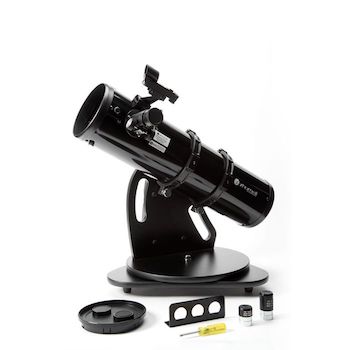
On High Point Scientific’s site
Our thoughts
The Zhumell Z130 (5”, 650mm focal length) is one of the largest and best tabletop Dobsonians, both in aperture and weight, and it is also a really good deal. At this price, a plastic focuser is to be expected, but it’s a real shame, since at the f/5 focal ratio of the Z130, collimation is quite crucial, and the plastic focuser can be fairly wobbly. However, this focuser is still a little sturdier than the Heritage/OneSky models.
What you can see with the 130/650 set of optics and the simple but sturdy telescope mount of the Zhumell Z130 is astounding, and gets staggeringly close to the planet-killer capabilities of the 6 inch f/8 Dobsonian.
BEST COLLAPSIBLE TABLETOP DOBSONIAN
SkyWatcher Heritage 130P/AWB OneSky 130
8/10
Very good, but not that great
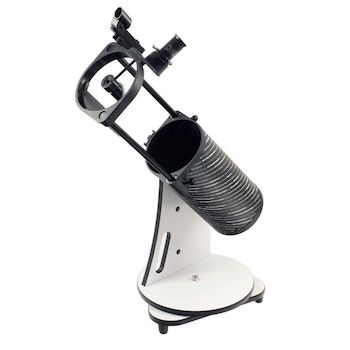
On High Point Scientific’s site
Our thoughts
The Heritage 130P, also sold as the AWB OneSky 130, has the same 5” f/5 optics set as the Z130, but in a collapsible tube and a smaller, more compact base. Its focuser is a little weaker than the Z130’s, but a simple addition of plumber’s tape can make it much sturdier and easier to hold collimation. Many users also add a light shroud to deal with stray light since the optical tube is otherwise nearly totally open.
BEST BUDGET TABLETOP DOBSONIAN
Zhumell Z114 Tabletop Dobsonian
8/10
Very good, but not that great
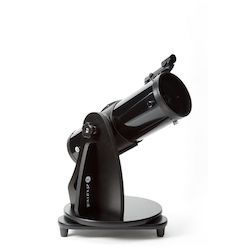
On High Point Scientific’s site
Our thoughts
The Zhumell Z114, which is identical to Orion’s StarBlast 4.5 (also a good scope, but usually just as expensive as the best 5″ Dobsonians), is usually cheaper and provides most of the power and light gathering of the 5” dobs for 2/3rds the price. Its eyepieces are, however, pretty bad and should be replaced pretty soon. They have short eye relief, so they are uncomfortable to use, and they have narrow fields of view. The telescope is a little cheap in build quality, with a plastic focuser, but that’s to be expected at this price range, and it is possible to shim the focuser drawtube.
BEST CHEAP “TOY” TABLETOP DOBSONIANS
Celestron FirstScope 3”/Orion FunScope 3” or Zhumell Z100/Orion Skyscanner 100
6/10
Recommended with reservations
Our thoughts
These small telescopes, which are the most portable Dobsonians available, are really at the point where their optics are getting flawed in order to sell them at the low price they’re being offered for. The Zhumell Z100 and Orion SkyScanner are 4” f/4 reflectors with nominal paraboloids that are pretty soft at high power. They work well for a cursory glance at the planets and the moon, but they’re very good for scanning the sky at low power and looking at the star fields and clusters of the milky way. Of course, in a dark sky, every Messier object is visible, but in most of them, the details are somewhat lacking.
The Celestron FirstScope and the Orion FunScope are much cheaper, and you get what you pay for. Their mirrors are short-focus spherical figures, which means they don’t really focus light properly at any magnification. The Moon is pretty bad, and the planets are downright disappointing. However, I find that it’s a fun toy if you want to try to find the bright deep-sky objects and scan star fields. Being able to change magnification can be an advantage over binoculars, as well as the sturdy and easy-to-use mount. These are great telescopes for very young kids. However, just beware that the included eyepieces with regular FirstScope are often absolute garbage. The H20 and the SR4 are borderline useless and full of distortions. If you can get the Celestron Cometron FirstScope or the Orion FunScope, they come with better accessories (the Cometron gets a K20 and a K10, while the FunScope gets a K20 and a K6 and a cheap Barlow, which is really too much magnification, but still better.)
BEST GIANT-TABLETOP DOBSONIANS
SkyWatcher Heritage 150P and Orion StarBlast 6
8/10
Very good, but not that great
Our thoughts
The SkyWatcher Heritage 150P is the 6” version of the OneSky/Heritage 130P. It’s a genuine beast fully extended on the table, but its collapsibility means it stores just as compactly as the other Table-Dobs. But its open tube also means it will need a light shroud, and its focuser also needs the plumber’s tape modification to hold onto heavy eyepieces.
The Orion StarBlast 6 is the bigger version of the Zhumell Z130. It comes with good-quality Plossl eyepieces in 25mm and 10mm focal lengths.
The optical quality of the six-inch short-focal-length tabletop Dobsonians is pretty good, but the quality varies a little more than the long-focus variety, since it’s harder to grind and figure a deep curve in a mirror than a relatively shallow one, and deeper curves are necessary for shorter telescopes. Thus, don’t expect the StarBlast 6 to be any cheaper than a full-size 6” Dobsonian. It will show a wider field of view, but it might have a very slightly lower maximum useful power. Also, being so short, it will take some more expensive short-focus eyepieces to reach high power.
THE ODD ONE OUT TABLETOP DOBSONIAN
Orion SkyQuest XT4.5
8/10
Very good, but not that great
Our thoughts
There are no other 4.5” f/8 Dobsonians on the market. Other 4.5” f/8 Newtonians are usually sold on undersized equatorial mounts, which are wobbly and finicky and no good at all. But the SkyQuest XT4.5 has a sturdy Dobsonian mount instead. This has the proportions and build style of the full-size Dobsonians, but it’s still a little short and ought to be elevated like the tabledobs (although it is the right height for a kid). These telescopes have really good optics for their size. Though the mirror is spherical, the curve so nearly matches a parabola at that focal length that the optics are better than some parabolas on shorter telescopes. These have a reputation for being really good on the planets. They won’t reach the wide field of view that the StarBlast 4.5/Zhumell Z114 will, but the long focal length means it’s easy to get to high magnifications with cheaper eyepieces, and the slow focal ratio of f/8 means that cheap eyepieces work with fewer distortions as well. That they come with high-quality Plossl eyepieces (a 25mm and a 10mm, providing 36x and 90x) is just the icing on the cake.
The trouble with this telescope is that, while it is genuinely a really good telescope, it costs significantly more than the larger aperture Zhumell Z130 and AWB OneSky 130. By all rights, those mirrors should be harder to fabricate, being larger, with deeper curves, and with parabolic figures. Those awful equatorial-mounted versions with the same good optics sell for a hundred dollars less! The pricing is just all wrong. This would be a perfect telescope if priced competitively with the 5” tabledob. Instead, it seems like it’s trying to compete with six-inch Dobsonians, and it just can’t. Keep an eye on the price: if these drop to below the price of a 5” tabledob, I would seriously consider SkyQuest XT4.5.
The Six-Inch Dobsonians
A 6” f/8 Dobsonian is a real planet-killer, and some of my very best ever views of planets have been through a 6” f/8 Dobsonian under good seeing conditions. However, the 6-inch Dobsonian can still do every Messier object in suburban skies, and there are enough objects to keep you busy for years. But it is small enough that you may become sick due to aperture fever and want a larger scope. It happened to me eventually, even though I loved my 6″ dob very much. A 6″ Dobsonian is a great scope to learn on because it’s lightweight and easy to use but still shows you a lot.
BEST 6 INCH DOBSONIAN OVERALL
Apertura DT6
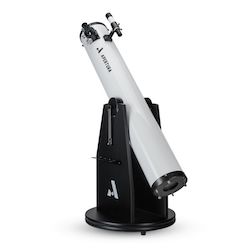
On High Point Scientific’s site
Our thoughts
The Apertura DT6 is one of the best Dobsonian telescopes on the market if you’re looking at a 6″ aperture. However, it is admittedly barebones. Nevertheless, among the six-inch Dobsonians, it has some nice features. The DT6 has a genuine all-metal Crayford focuser, which is smooth and sturdy. Its altitude bearings are simple–plastic bearings riding on Teflon, held down by tension springs–however, this method works very well, and simulates the effect of the larger Teflon-on-Formica bearings of larger amateur-built telescopes. Tension can not be adjusted, but the telescope is generally balanced very well. You will want to pick up some additional eyepieces–the DT6 only comes with one, a pretty good 25mm Plossl providing 48x.
The Apertura DT6 weighs 38 lbs. fully assembled.
#2 CHOICE ON 6 INCH DOBSONIANS
SkyWatcher Classic 150P
9/10
Nearly flawless

On High Point Scientific’s site
Our thoughts
The SkyWatcher Classic 150P (the P is for “parabolic,” as all of these mirrors are) does almost all of what the DT6 does, but you get two eyepieces (some moderately good 25mm and 10mm modified achromats, which aren’t quite as good as the single 25mm Plossl, but provide a wider range of magnifications–48x and 120x).
The SkyWatcher Classic 150P has a few weird quirks, though. The focuser, though all-metal, is a rack and pinion design with a 2” drawtube. The rack and pinion isn’t quite as smooth as a Crayford can be, but that isn’t a big deal with the gentle narrow light cone of an f/8 telescope–the position of best focus is larger and easier to accommodate in an f/8 telescope than in an f/5 or f/6 one. However, the choice of a 2” drawtube is a little weird. In order to provide superb planetary performance, the secondary mirror of the 150/1200 optics set is kept small, just enough to illuminate a 1.25” diameter field of view. So you can’t actually take advantage of the wider field of view given by 2” diameter eyepieces because you’d see a lot of darkened edges.
The altitude bearings are a bit of a weak point, but with the six incher they shouldn’t be too bad. The tension adjustment handles do make it easy to carry around, but they can also jab you in the belly or chest if you’re observing near the zenith.
The SkyWatcher Classic 150P weighs 40 lbs fully assembled.
NOT BAD, NOT GREAT 6″ DOBSONIANS
Orion SkyQuest XT6 Classic and Plus
7/10
Solid with some issues
Our thoughts
The Orion XT6 is not a bad telescope, exactly (remember it has the same excellent optics as the other 6″ Dobsonian telescopes). If this telescope is in stock and you can afford it, and none of the others are, you won’t be missing out on too much, but it is important to be aware of the flaws.
The focuser is a 1.25” plastic rack and pinion focuser. This is a pretty big disappointment because they’re wobbly and a little flexible. In practice, that means it won’t hold collimation well. If you collimate it properly, then put a heavy eyepiece in, the focuser drawtube will sag a little bit, and then the eyepiece and the mirrors will no longer be aligned properly. This isn’t as big a deal at f/8 as it is at f/5 (some of the shorter tabletop dobs have the same focuser), but at XT6’s price range, it’s an unfortunate cost cut.
The telescope also uses a “Red Dot Finder,” which projects a little red dot through a small window out into the sky. Though I like red dot finders fine for smaller scopes, on a telescope with a focal length of 1200mm, a red dot finder isn’t really enough to reliably find many objects, which require star-hopping using asterisms that are too dim to see with your eye, and too large to fit into the field of view of a big telescope. The other 6″ Dobsonian telescopes use real optical straight-thru finderscopes instead, and though they’re slightly less pleasant ergonomically, they are better for star-hopping.
Could the XT6-Plus save us from a wobbly focuser and a no-power finder? No. The more expensive version, which is typically more expensive than the other 6 inch dobs, has the same flawed plastic focuser and the same red dot finder. It merely adds a 10mm Plossl eyepiece for 120x magnificaiton, and a 2x Barlow which, when added to the other eyepieces, provides either 96x or 240x. The XT6-Plus also regrettably has the same flawed adjustable altitude bearing system as the SkyWatcher 150P, albeit its long jab-you-in-the-gut handles are replaced with low-profile knobs.
There is a fix for the plastic focuser, described in this thread by SkyMuse on CloudyNights, where you shim the focuser drawtube with Teflon strips.
While you can’t easily replace the focuser outright, you can replace the finderscope with an aftermarket device. To keep the scope balanced, I don’t recommend going over a 40mm aperture finder. Finders come in straight-thru-upside-down-image and right-angle-correct-image varieties.
The XT6 weighs 34 lbs fully assembled, making it actually the lightest of the commercial 6″ Dobsonian telescopes. If shaving off six pounds over the skywatcher or four pounds over the DT6 makes a difference to you, consider the SkyQuest XT6. Just be careful you don’t bang the focuser on the door when you’re taking the telescope outside.
I’ll also spare a thought for the Orion SkyLine 6”. It’s a GSO-sourced Dobsonian like the larger SkyLines, but it doesn’t have any of the deluxe features of the other SkyLines, really being more comparable to the DT6. But since it is much more expensive than the Apertura DT6, which is nearly identical aside from the inclusion of an additional 9mm Plossl, I wouldn’t be inclined to recommend it. Only go for it if you can somehow find one cheaper than the DT6.
The Eight-Inch Dobsonian Telescope
There are quite a few more options available in the 8 and 10 inch size classes, ranging from budget designs to slightly better “deluxe” models. I would like to remind you that the optics are the same in all of these telescopes.
An 8″ dobsonian telescope has enough aperture to keep you busy for a long time, maybe forever. Some people never feel the need to use a larger telescope, and those that do will probably want an eight incher anyway. It is probably the most agreed-upon best compromise in weight/bulk versus light gathering, and they have very nice, sharp optics which will show fantastic detail in the moon and planets without being thwarted by turbulent air/seeing conditions.
At f/6, collimation (optical alignment) is starting to become important. Be sure you learn how to do this alignment procedure at some point if you want the telescope to show good images.
BEST 8 INCH DOBSONIANS OVERALL
The GSO-Deluxe Dobs (Apertura AD8, Zhumell Z8, and Orion SkyLine 8)

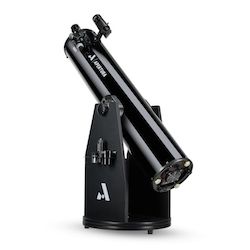
On High Point Scientific’s site
Our thoughts
Those two brands are just two names for the exact same telescope and is the best dobsonian telescope in the 8″ aperture group. The Apertura AD8 and the Zhumell Z8 differ only in name; they are exactly identical in every other way–same optics, same accessories, same quality, same appearance aside from the logos. Beware that they do differ in price and availability, though! The Orion-SkyLine, Zhumell, and Apertura Dobsonians are both sourced from Guan Sheng Optical in Taiwan, and outside of the USA, they’re usually marketed under the GSO Deluxe Dobsonian label (albeit with a different paint job and sometimes different accessories).
The GSO-Deluxe Dobsonians have the best set of default accessories among all of the imported dobs, but they’re also pretty reliably the most expensive. For your top dollar, you get a 30mm wide-angle eyepiece that provides a bright image and a wide field of view, a 9mm Plossl that provides 133x high magnification, a big 8×50 Right-Angle-Correct-Image finderscope, a small moon filter to darken the image as seen through 1.25” eyepieces, and a laser collimator.
A laser collimator is really not a great choice. Lasers have the connotation of being high-precision devices, but the way they are used in a normal laser collimator means they actually amplify the error of the secondary mirror–which means you have to be extremely precise when collimating the secondary mirror so that you can be precise when collimating the primary mirror. But the thing is, secondary mirror collimation does not have to be precise–good enough is good enough, as long as it does not vignette the field of view, it will not affect the figure of the image. It is only the alignment between the primary mirror and the eyepiece that matters for collimation, so sight-tubes, Cheshires, and collimation caps can actually be significantly more precise! If you’re having trouble with your laser, consider getting a Cheshire collimating eyepiece.
The telescope’s focuser is a very nice dual-speed focuser, allowing you to quickly do a rough focus to get to the eyepiece’s focus range, and then use a small knob with a 1:11 speed reduction to get very fine control over the focus position.
The bearings of the GSO-Deluxe dobs are also a weird and unique design using roller bearings and tension adjustment knobs. The bearings can also be repositioned slightly to balance the Dobsonian when using heavy eyepieces.
The telescope also includes a battery-powered fan, which will cool the mirror. This isn’t a big deal in the 8″ dobs, but it can reduce the acclimation time and get you observing at high resolution faster. The effect is much more pronounced with heavier telescopes–the big ones might take an hour or more to cool down.
The Apertura AD8 and Zhumell Z8 have a total assembled weight of 52 lbs, making them the heaviest of the imported 8” Dobsonians.
MOST COMPACT 8 INCH DOBSONIAN
SkyWatcher FlexTube 200P
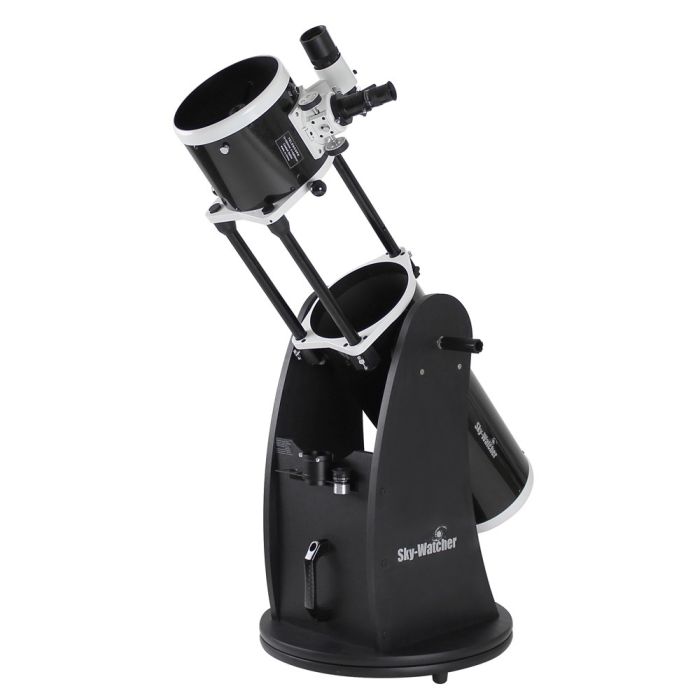
On High Point Scientific’s site
Our thoughts
The SkyWatcher FlexTube 200P has a curious design–rather than a solid tube, it has an Upper Tube Assembly, a Mirror Tube, and three truss tubes holding the two together. To be sure, a telescope is, after all, mostly empty space, so as long as stray light is under control, you just need to hold the mirrors and eyepiece apart at the right distance.
The exact utility of the FlexTube is subtler than you might expect–how often do you really need to collapse down just 13 inches of vertical height? I find that the collapsible tube does help when transporting the scope in my SUV. The FlexTube Dobs can be stored in less space than a solid tube Dob. However, those truss tubes actually weigh more than the solid optical tubes they replace, so it’s actually heavier than the Classic version of this telescope.
The FlexTube 200P has similar deluxe pricing to the GSO-Deluxe, but has slightly inferior accessories. A 25mm and 10mm Plossl eyepiece work fine in this scope, providing 48x and 120x, respectively. The finder is a big 8×50 right-angle-finder, but it’s actually not a right-angle-correct-image finder–the diagonal is a mirror instead of a prism, so the view is annoyingly mirrored. There is no fan and no collimating device.
Also beware that the SkyWatcher dobs have a flawed altitude bearing system–the bearings are plastic circles that rest on plastic cylinders, which can cause problems. It can be a little annoying on the eight inch model, but I’ll save the full critique for the ten incher where its flaws are much clearer.
BEST BUDGET 8 INCH DOBSONIAN
Apertura DT8
8/10
Very good, but not that great
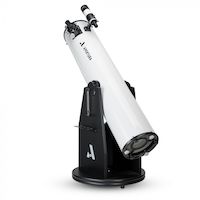
On High Point Scientific’s site
Our thoughts
The Apertura DT8 is a very barebones telescope, just like the DT6. It uses the same spring-tension altitude bearings and it has the same single 25mm Plossl eyepiece. Its finderscope is larger, an 8×50 instead of a 6×30, but it is still a simple straight-thru device. The focuser is a 2” crayford, which is nice and smooth and can be used with large, wide-field eyepieces. However, it is a 1-speed focuser only.
Despite the Apertura DT8‘s simplicity, its simpler mount is just as functional as the more complicated solutions, and it’s a fully functional 8” Dobsonian with great optics.
#2 CHOICE BUDGET 8 INCH DOBSONIAN
SkyWatcher Classic 200P
8/10
Very good, but not that great
Our thoughts
The SkyWatcher Classic 200P is highly comparable to the DT8. It has a similar 1-speed crayford focuser and an 8×50 straight-thru finderscope, but it has the lower quality SkyWatcher tension-adjustment-handle altitude bearings instead of the simpler and smoother spring-tension bearings of the DT8. Its eyepiece selection is a bit of a mixed bag. Yes, there are two eyepieces, a 25mm and a 10mm, but they’re cheap Modified Achromats, which have a narrower field of view than the Plossls that come standard on most telescopes in this price range. For a telescope this expensive, better eyepieces would have been appreciated, but they’re fine enough to get started with.
ORION’S BUDGET OPTION AND ITS NOT-QUITE DELUXE VARIANT
SkyQuest XT8 Classic and XT8 Plus
8/10
Very good, but not that great
Our thoughts
Orion’s Dobsonians are much better in the 8” and above categories than the 6” dobs, primarily because they ditched the cheap plastic focuser. The XT8 Classic has a 2” Crayford focuser, and the XT8 Plus has a 2” Dual-Speed focuser like the GSO-Deluxe Dobsonians. Both scopes still only have a red dot finder instead of a real optical finderscope.
The XT8 Classic is priced in the budget category, and aside from the red dot finder replacing a real finderscope, it holds its own against the Apertura DT8, using the same bearing style and a similar focuser. It also has just one eyepiece, a 25mm Plossl.
The Ten and Twelve Inch Dobsonians:
The 10” Dobsonian optics tend to be a little less tidy than the 8 inchers, since the curve is deeper and the mirror is larger, but they still pull ahead in practical image quality due to the larger aperture. The extra light gathering over the 10″ Dobsonians makes things a little easier and brighter and will be noticed with dim objects more than bright ones. For those looking for an “XL” version of the eight incher, especially if you’re under dark skies, this is the one to go for. But you will have to deal with the added weight and bulk.
The 12 inch Dobsonians might give you sticker shock–they’re much more expensive than the 10″ dobs, let alone the 8″. They’re also getting really, really bulky, to the point of severe inconvenience. One owner I know of a GSO 12 inch scope needs two people to get it outside, and many 12″ dobsonian owners build wheeled carts or dollies to push the telescope outside with. Orion will sell you a “Dob Dolly” which will work for this as well. The reward in the 12 inch dobsonians, the XXL if you like, is that the images can be truly spectacular. The dim satellites of Saturn and Uranus become pretty easy. Pluto and many asteroids are doable (as points of light), and this thing will gobble up the light of dim galaxies. The “Herschel 400 Observing Challenge” run by the Astronomical League, a list of 400 obscure and interesting objects to hunt down and observe, is not quite doable with an eight-inch dob, but was designed to be done with a ten incher. The resolution and brightness are high enough to show many smaller globular clusters and planetary nebulae with much more detail than an 8″.
Each of the telescopes here has the same accessories and mechanical design as their 8-inch siblings within each brand and line.
BEST 10″, 12″ DOBSONIANS OVERALL
The GSO-Deluxe Dobs (Apertura AD10/AD12, Zhumell Z10/Z12, and Orion SkyLine 10/12)
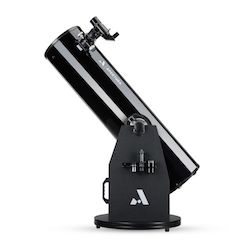
On High Point Scientific’s site
Our thoughts
For all the same reasons that the GSO 8″ Dobsonians are superlative, so too are the GSO 10 and 12 inch Dobsonians. It’s here that the buttery smooth motions of the roller bearings really start to make a difference, and at f/5 the light cone is broad enough that focus accommodation becomes more difficult, so the Dual-Speed Focuser with 10:1 gear reduction is much more useful. The fans are now much more important for cooling the mirror when it’s cool out, and the wide field of the 30mm eyepiece becomes more important for star-hopping in the longer-focal-length 12 incher.
The downside is that the GSO-Deluxe series are usually the heaviest in their size class and there are no handles except for a single handle on the front of the base, which means the telescope practically has to be carried in two pieces, separating the OTA from the mount and carrying the mount first–or it must be carried on a cart. I wouldn’t want my only telescope to be a 12” GSO; it’d just be too heavy, and I’d want a smaller one to supplement it.
BEST BUDGET 10″, 12″ DOBSONIANS
Apertura DT10/DT12 or Orion SkyQuest XT10/XT12)
8/10
Very good, but not that great
Our thoughts
The Orion SkyQuest XT10/XT12 Classic and the Apertura DT10/DT12 are each excellent affordable options for Big Dobs, if you can call this price affordable. It’s all relative, of course. Though the XT10/12 still uses a red dot finder, at this price, the additional $60-100 for a right-angle-correct-image finder shouldn’t be too much of an imposition when you get tired of findering with a red dot. You will also want a 1.25” 32mm Plossl or another wide-field 2-inch eyepiece to take advantage of the widest possible field, especially with the longer focal length of the 12-inch dob. Keep the eyepiece focal length shorter than 35mm, around 30mm or so, to prevent underpowering the telescope and losing light at f/5. And then you’ll want a higher power eyepiece.
The trouble is, at this size, the bearings do get pretty rough. The 10 inch dob may be a little frustrating to track with at high power, and the 12″ Dobsonian is worse still. You’ve really got to shove the scope around to aim it, compared to the smaller dobs. The altitude bearings don’t change in size between the 6″ and the 12″, so the bearings are smaller in the relative area in a place where bigger is always better. The diagonal motion is rarely smooth.
COMPACT 10″, 12″ DOBSONIANS
The SkyWatcher FlexTube 250P and 300P
Our thoughts
The SkyWatcher FlexTube 250P is the 10” Dobsonian I personally own. It is a real light bucket and has shown me some spectacular sights. But I’m not sure I’d recommend this specific Dob unless you really cared about the additional 13 inches of saved space in the 10″ dob and 19 inches in the 12″ dob.
With the 12 incher, I’d seriously start thinking about that saved space, though! The 6, 8, and 10 inch tubes (44” long) fit across the back bench-seat in a small car, but you might not be able to fit the 12’s (55” long) tube in a small car unless you go for a collapsible tube or a truss tube.
Remember that this telescope does have the same frustrating bearing design as the SkyWatcher Classic series and Orion XT-series Plus. At this size, the bearings are really a problem, especially in altitude. The bearings are slightly different in design to account for the azimuth motion, but the altitude motion is exactly the same. And that’s a real shame because what was a minor quibble in the 6 and 8 inchers is becoming a real flaw in the 10 incher and a problem in the 12 incher.
The altitude bearings are just plastic circles riding on hard white plastic cylinders screwed into the base. Over time those plastic cylinders get harder, more fragile, and yellowed, and they can crack or break. When moved with the tension too tight, they can unscrew themselves and drop down into the base. The tension adjustment knobs hold the telescope into the dob base, and when tightened, they can very nearly lock the motions down. When loosened, motions are fairly smooth, but not ideal. However, the telescopes are top-heavy enough that in practice, you always need the telescope adjustment locked down pretty tight, which means the telescope tends to stick as you move it. When pointing below perhaps 40 degrees, the telescope tends to drift forward in spurts. A magnetic counterweight can fix this to some extent, but it’s never really smooth.
The long handles are very useful on the 10” SkyWatcher when carrying it outside. However, I feel like two handholds on each side of the base and replacing the long handles with low profile knobs (or better yet, a traditional large-diameter altitude bearing riding on Teflon)
EXTREME COMPACT 10″, 12″ DOBSONIANS
Explore Scientific Truss Dobsonians
Our thoughts
One of the few manufacturers of affordable truss-Dobsonians, Explore Scientific’s Truss Dobsonian leaves some to be desired. However, at an aperture where it’s getting difficult to transport the telescope around, you should be aware of this option in the 10” and 12” varieties, and in fact in larger sizes. (Other brands introduce Truss Dobs in giant apertures.)
What is a Truss Dobsonian? Instead of a solid tube, or a collapsible tube with captive-hardware struts, a Truss Dobsonian uses a Mirror Box, an Upper Tube Assembly, Truss Poles, and a Rocker Platform. The Mirror Box and the Upper Tube Assembly are connected by Truss Poles, and then the Mirror Box rests on the Rocker. The profile is somewhat lower than a traditional Dobsonian.
The main advantage is the Dobsonian can be broken apart and stored in a manner much more compact than the solid tube or even SkyWatcher FlexTube counterparts. If transporting to a dark site is important to you, consider a Truss Dob. The Truss Dob is also significantly more lightweight.
One nice feature is that the altitude bearings are designed the same way as traditional amateur-built bearings, and those bearings are used in highly expensive, luxury-priced Dobsonians.
The Truss Dob is fairly well outfitted with a 2” Dual-Speed focuser and integrated cooling fans, but it doesn’t include any eyepieces, and the only finderscope is a red dot finder. In order to use heavy eyepieces, you’ll need to buy aftermarket counterweights. You’ll also want to buy the aftermarket light shroud to control stray light since the stock model doesn’t control stray light particularly well.
This telescope, with its finicky assembly and disassembly and strange collimation system, makes a poor “first serious telescope,” but could make a good choice as a later telescope once you’ve learned the ropes and already have a set of eyepieces you like.
Also, beware that for the compactness and lightweight, you have dramatically increased the price over the solid tube models. Explore Scientific Truss Tube Dobsonians are more expensive than any of the others.
Considering Luxury Dobsonian Models?
If you have a high enough budget, consider looking into the large-aperture luxury Dobsonians built by Obsession, Hubble Optics, and a small handful of other large-aperture telescope vendors. Their prices run considerably higher than the imported Dobsonians of the same aperture (12”, 14”, and 16” overlap with some of the imported models; above that, you must go for the luxury models). You can be guaranteed extremely excellent optics and buttery smooth mechanics. But these models are all truss Dobs, which require being taken apart and put back together when transporting due to their weight.
Frequently Asked Questions Related to Dobsonians
Large Dobsonians can show the Moon as a full disk, or zoom in to see lots of fine detail and many craters and other lunar features. They can see surface features on the planets, and they can easily show you Jupiter’s moons and Saturn’s rings, and you can see countless deep-sky-objects, including galaxies, nebulae, and star clusters. However, galaxies and nebulae will look gray and dim in any telescope, so don’t expect Hubble-type views.
Dobsonians are perhaps the best beginner telescopes due to their sturdy construction and ease of use. Telescopes on tripod-based mounts are usually more finicky and have more bells and whistles to figure out, so to speak.
Because they use 4 or 5 foot long optical tubes, Dobsonians are bulky, and you may be surprised at how much bigger the telescope seems in person compared to photos. However, they don’t actually take up that much floor space. When stored with the tube vertical, the only floor space occupied is about a 2-foot circular area. Dobsonians can be transported in a car, but the solid tube versions will usually take up the whole backseat, and the rockerbox will take up another seat. Tabletop Dobsonians are smaller and much more compact, but their bases are still a little bulky compared to certain tripod-based arrangements.
Newtonian” refers to the OTA or Optical Tube Assembly; the actual telescope itself. It has a curved primary mirror at the back, a flat diagonal mirror at the front, and you look in through the front using eyepiece lenses. Newtonians can be put on any kind of mount. “Dobsonian” is the name that refers to a Newtonian placed on an altitude-azimuth rockerbox. All Dobsonians are Newtonians, but not all Newtonians are Dobsonians.
A Tabletop Dobsonian is a small, compact Newtonian telescope on a sturdy, low-profile rocker-arm/lazy-susan mount. It’s short enough that for comfortable viewing you should put it on a sturdy table or stool instead of the ground. Full-sized Dobsonians are ground-standing units that sit on the ground, and then you sit in a chair to look through the eyepiece.
Refractors are telescopes that use a lens in the front and an eyepiece in the back. Cassegrains are telescopes with a concave primary curved mirror in the back, a convex secondary mirror in the front, and then you look through an eyepiece in the back. Maksutov- and Schmidt-Cassegrains put corrector lenses on the front. Because of the complexity of these designs, they’re more expensive than a Newtonian of a similar aperture, yet the Newtonian often performs just as good. Since these other designs have the eyepiece in the back, they require tripods to elevate them. Those tripods and their associated mounts are either much wobblier than a Dobsonian rockerbox, or much more expensive.
Dobsonians can be used for simple shots of the moon. They can even be used (with some difficulty) for photographing planets. But they can’t be used for deep sky astrophotography because they don’t have a way of automatically tracking the sky for long exposure shots.
The best Dobsonian telescope is one that has good, sharp optics, a smooth and stable focuser mechanism, and a smooth, balanced mount that stays where you want it but will let you smoothly push it and nudge it on a diagonal. Most commercial Dobsonians get the optics and the focuser right, but the mount can be a little sticky, especially at the largest apertures.
The largest one which you can afford and handle the bulk of.
Dobsonians may need to be collimated before being used at high magnifications, especially the larger ones. Over time, their mirrors may get dirty, but cleaning should only be done very, very rarely, only when the images are actually noticeably worse. It’s better to use the dust caps properly and prevent dust and dirt from getting on the mirror to begin with. On some models, the bearings can come loose over time. Should be nothing a screwdriver can’t fix. Because Dobsonians are so simple, there’s not a whole lot that can go wrong.
